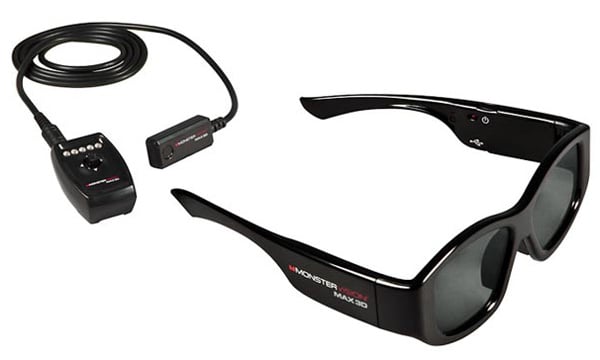MonsterVision MAX 3D Eyewear System with Active Sync
 While in the process of reviewing the ASRock Vision 3D home theater PC a few months back, I became entrenched in all things 3DTV. At the time, I had already been building up a new home theater around a Samsung 3D TV and the opportunity coincidentally arose to evaluate a 3D-capable device, so I jumped at the chance. With that ASRock HTPC and some support from NVIDIA and Cyberlink, I was able to check out 3D photos, 3D Blu-Rays, 3D TV, and of course 3D games.
While in the process of reviewing the ASRock Vision 3D home theater PC a few months back, I became entrenched in all things 3DTV. At the time, I had already been building up a new home theater around a Samsung 3D TV and the opportunity coincidentally arose to evaluate a 3D-capable device, so I jumped at the chance. With that ASRock HTPC and some support from NVIDIA and Cyberlink, I was able to check out 3D photos, 3D Blu-Rays, 3D TV, and of course 3D games.
Throughout the review process, I had been using the Samsung active-shutter glasses included with my TV. While I found them to be decent, I felt that their overall quality seemed to be a slight step down from the glasses included in the NVIDIA 3D Vision kit I reviewed when they were first introduced. Regardless, I trudged on and ultimately came away impressed by that HTPC and the NVIDIA 3DTV Play technology at its heart.
Just before wrapping up that piece, I was also given the opportunity to evaluate a newly released set of “universal” 3D glasses from the folks at Monster. I thought it would make for an interesting comparison at the very least since I already had access to two other types of active shutter glasses.
Right away, the MonsterVision MAX 3D Eyewear System with Active Sync which I tested offed some clear advantages. First off, they use an RF transmitter, so there are no line-of-sight issues like there are with glasses that use IR technology. Using RF meant the glasses stated in-sync regardless of whether I turned my head too far to one side, or even walked around the room, as long as I stayed within the transmitted roughly 30-foot range. With IR (Infra-Red) technology, if the light from the IR emitter isn’t directly in-line with the sensor on the glasses, a sync can’t be established—in other words, “No 3D for you!”
Another advantage to the MonsterVision MAX 3D glasses were their relatively tall lenses and thick frames. The lenses in these glasses extended further above and below my eyes and they were wrapped in a thick frame which helped block out more ambient light while at the same time giving me a larger field of view through the lenses. These are important points to consider, because it made for a more enjoyable overall viewing experience (at least for me) due to the fact that my eyes had to do less “re-adjusting” if my attention was drawn to another light source for whatever reason while viewing a 3D movie—it seems I was always looking through the lenses and not above or below them like was possible with the Samsung glasses.
MonsterVision MAX 3D Eyewear System with Active Sync
The build quality and overall quality of the MonsterVision MAX 3D optics also seemed very good. Admittedly, I found it very difficult to spot clear viewing-quality differences when switching quickly between the Samsung, NVIDIA, and MonsterVision MAX 3D glasses, but uniformity and contrast did seem ever so slightly better with the MAX 3D glasses. This was perhaps due to them better covering my eyes though, and not because Monster actually uses higher-quality optics. I should also note that battery life is awesome too. Monster claims the glasses will last for about 60 hours of use before needing a charge. I can’t confirm that actual number because I wasn’t about to sit through 30 movies, but I didn’t have to recharge the things for weeks on end.
The only real downsides to the MonsterVision MAX 3D Eyewear System with Active Sync kit were its installation and price point. My particular HDTV does not have an IR sync port, so I was required to install an IR sensor (which is included with the kit), along with the Max3D RF transmitter, plus a USB power cable (also included) to provide the necessary juice to run the whole setup. In addition, proper placement of the IR sensor took some work. Although I was able to neatly bundle the wires and transmitter behind my TV, and neatly mount the IR sensor to my TV, the setup seems somewhat “kludgey”. Once installed properly though, it did work well. And if your TV does have an IR Sync port, installation will most definitely be easier and cleaner.
As for pricing the full MonsterVision MAX 3D Eyewear System with Active Sync has an MSRP of $229, but street prices hover closer to $179. That price includes the RF transmitter, IR sensor, the glasses, and all necessary cables to connect the kit to virtually any 3DTV. While the kit does offer some distinct advantages over some others, the price is pretty steep when you consider Samsung’s active shutter glasses can be had for about $50 a pair.
While the MonsterVision MAX 3D Eyewear System with Active Sync may be somewhat pricey in light of some other solutions, I find myself using them far more often than the Samsung glasses included with my HDTV. In fact, I reach for the MAX 3D glasses first due to their larger lenses and use of RF technology. They may cost more, but not having to worry about the glasses staying in sync and the better overall viewing experience offered by the larger / taller lenses definitely add value.


